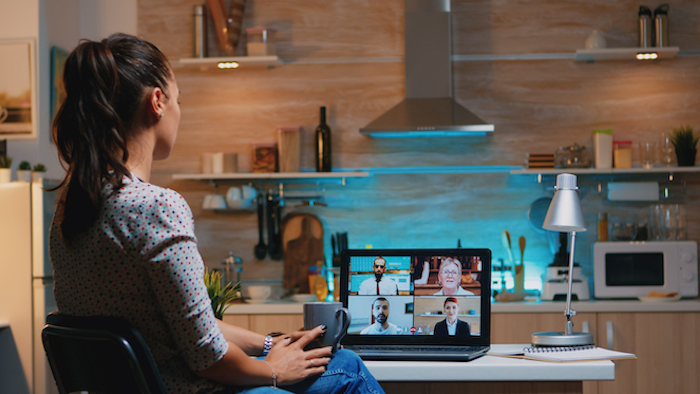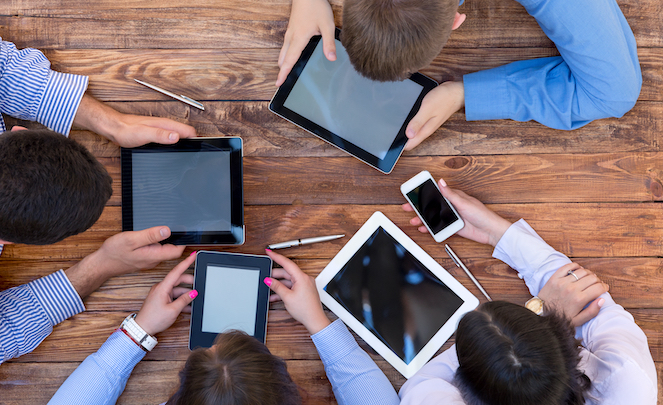The morning alarm goes off and you are up and running. Get the kids ready for school and get yourself ready for work. You begin to open your home office and prepare your computer for the list of Zoom meetings you have scheduled for the day.
But wait, COVID is still here, and your kids are back home again for a week. You get the kids breakfast and send them to their respective computers. You’ve given up your office space to them while you work at the kitchen table. Your scheduled reentry into the work place has once again been delayed.
You are in the kitchen so you can tell when they’ve snuck away from their computers and found their way to the refrigerator – away from their classes online. Honestly, you find yourself grabbing snacks in there more than usual as well.
Lunch comes as a disruption to you, as you were in the middle of a Zoom meeting, but it is time for the kids to eat. You step away from the meeting and throw together some lunch, and try to keep the kids quiet, as you head back to your computer. You are half-engaged and half-wondering when you can get back into the office to see your colleagues as real people instead of faces on a screen.
Afternoon comes and the kids are staring at their computers but paying more attention to their phones. At least, for the time being, you can work in peace, but the fact is they are not learning. And their teachers have no idea they are not present. Nor are they engaged, at least not in the classwork. Instead, they are zoned out, scrolling through the Apps on their phones.
School is out at 2:30 and the house noise is abruptly ascending. You peek from the kitchen and see them watching TV and playing games on their phones. You are still connected to the computer screen but are also watching the family room activity, worried about what might be breaking.
As dinner approaches, you decide if you will order something out or toss some leftovers together. You have your phone right next to you and decide to order something from your phone, while you listen to the late afternoon meeting.
You make sure everyone is fed and then head back to work. The kids are doing homework, managing their social media accounts, and texting with friends – all on the screen. You are back at work answering the 70 emails you didn’t get to throughout the day.
More screen time.
About an hour in you remember you are supposed to be online for the Zoom meeting with a group of women entrepreneurs that used to meet in person every month. You get on, say hello, and then explain that you are behind at work and so must keep it short. You get off and again shift to your work screen to finish up your to-do list for the day, minus the five or so things you must move to tomorrow’s list because you could not accomplish them during the day.
Finally, bedtime arrives and you jump into bed with your Kindle or iPad and try to catch a couple pages of the current book you are digesting.
Goodnight.
Day two. Repeat.
Now take a deep breath. Pause.
Sound familiar? Regardless of your work situation or whether you are parenting kids while working, the last two years have seen a substantial increase in screen time for both school-aged children and adults. Many areas of the country are still in COVID protocol. Consequentially you may still be working remotely, and your children are in and out of hybrid or full-time class situations.
We’re still on screens.
Today’s screens include computers, laptops, phones, Kindles, notebooks, tablets, and many others.
According to a recent study by JAMA Pediatrics, adolescent screen time away from school increased from 3.8 hours a day to 7.7 hours.(1) When you consider that for the past two years much of the class time was also virtual, between 5-7 hours a day, it is easy to understand that our youth are online more than offline.
It isn’t much different for the adult workplace. According to the Nielson Total Audience Report, adults are spending almost 12 hours per day online, up 60-80% from pre-pandemic reports.(2)
Another study reported that total hours across all screens totaled 17.5 hours for heavy users. (3)

The Effects
There are many pros and cons about the ability to be online. Obviously, we have just been through, and for many are still immersed in, a pandemic. The fact that we have had the capacity and the opportunity, for those that are lucky enough, to be online and in touch with employees, colleagues, family, and friends has been a true blessing.
We’ve had online work meetings and events which have allowed many workers to remain employed. And to work from the comfort of home allowing for multitasking, breaks to work out, and less commute equals more time with family. Online and hybrid classes have allowed many students to remain on a track to graduate.
And we can’t leave out the family gatherings, happy hours, funerals, engagements, weddings, birthday parties, classes, graduations and much more. These precious moments were all captured because technology made it possible.
That’s the good news.
However, there are also some grave concerns regarding all the screen time we’ve had to endure these last couple years.
According to a UCLA-led study, Americans drank more alcohol, smoked more, spent more time in front of the screen, and exercised less during the pandemic-related business closures and stay-at-home orders.(4) For many these same circumstances are continuing even today.
More screen time has also caused us to become more distracted, to lose concentration easier and to sleep less effectively. Our mental and physical well-being have surely been tested these past two years.
Many are zoned out more than zoned in during our day. As a result, we are becoming less and less productive while targeted outcomes are falling short. For some, the stress of falling behind and not attaining outcomes are piling up at work.
Furthermore, there is the stress and mental health of our children, who are struggling due to lack of social engagement and the fact that they stare at screens for longer hours in the day – away from others.
How can we keep it together for our jobs, teams, and families?
Long-term effects of screen time
In the long run, we are becoming less productive, less engaged, less healthy, and less social.
Here is an extensive list of some of the effects of extensive screen time:
- Burnout
- Feeling of being overwhelmed
- Depression
- Less engaged as the time increases
- Social isolation
- Low energy
- Easily angered
- More moody
- Losing interest in work
- Quitting
- Changing jobs
- Eye Strain – Headaches – Migraines
- Not sleeping well
- Weight gain
- More sedentary
- More smoking / drinking

Dealing with Excessive Screen Time
Awareness is the key. It is all too familiar and so easy to get lost on screen, literally. I’ve held discussions with some who say they forget meals and work longer hours because everything is so accessible right in the comfort of the home.
So how can we deal with the screen time and the additional hours of work?
Scheduled breaks away from the screen
Like the story above, children, especially those who are younger in age, cause built in breaks throughout the day. That is if you can call them breaks. Any break, short or long, away from the screen gives eyes and brains a chance to re-energize.
Families without children need to schedule breaks, or they may be forgotten. One option is termed the 20/20/20 method. Advanced Eye Care Aesthetics suggests you look up from the screen every 20 minutes at something about 20 feet away for about 20 seconds. This is hard to do. Twenty minutes feels like 20 seconds when you are focused on your work, therefore it is usually skipped.
Many people now have Apple or other fitness watches which buzz when it’s time to stand. This is another way to take a break. That doesn’t mean stand up and continue to gaze at the screen, though. Stand up and force yourself to focus on something else. Take a breather. Walk to another room and back. Go fill the water bottle. Yes, even peek in the refrigerator. One colleague of mine reports taking a walk outside for 10 minutes for every significant task completed.
Look Away When Thinking
During the day, when you are in the thinking mode, look away or go sit in another room. It is easy to stay seated at the desk and continue to stare at the screen when thinking. You may have to literally practice looking, or moving, away.
Take meetings as calls
As a remote worker, when I can turn a meeting into a phone call, it allows me to walk and talk. Once upon a time, all remote meetings were actual calls. Today it is the opposite. It’s refreshing when every meeting doesn’t have to be on video.
Blue light glasses
As someone who works on computers most of the day, I highly recommend Blue Light Glasses to reduce eye strain. These are made for day and night heavy screen use and can be ordered online – of course.
You can also adjust the brightness of your screen for day and night use. The brighter the screen and the closer you sit to it, the harder it is for your eyes to focus causing more eye strain.

Find a window
If you have a window in your office space, use it. If you don’t have one in your office, find or put a chair close to a window in your home. Looking outside and giving nature a minute for your health is a positive motivator, even if it is only for a quick minute. Just allowing some sunshine into our workspace can boost your mood and energy level.
There is also the option of sun lamps to try to brighten the workspace. Many offices were transformed and moved into home basements, over the past two years, and sun lamps are a possibility to shed a little light where there are no windows.
Set some “no screen time” rules
This may take practice as well. Screens are everywhere. You may work on a desktop, sometimes multiple screens, or laptop all day, but you also have screens on your phone, tablet, iPad, and Kindle. Many are even watching their favorite shows on screens held much closer to the eyes than a television used to be.
Think of what you can do to limit the time on screens. For example, you could purchase a physical book to hold and read as opposed to using a Kindle for every book. You could make a rule for yourself to not be online when you are working out. Leave your phone somewhere else while you are eating or taking a break.
During this time, don’t forget to do something for yourself. Breathe, relax, and try to enjoy something other than work. Be deliberate about some “me time.”
Get outside
Whenever you can, take a minute to get outside. There is nothing like fresh air to help re-energize mood and energy levels. Go get the mail. Go for a walk. Take the dogs to dog park or for a walk around the block. Take a drive just to get outside. Drive through nature or some other scenic route.
Ask for help
When you are feeling discouraged, lonely, depressed, or overwhelmed, don’t be afraid to ask for help. Many folks are terrible about asking others for help. But it can make a big difference when working your way out of a slump or during troubled times.
We are made to be social and with other people. There is not too much that we can successfully accomplish without the help of others. Don’t be afraid to reach out.
Screens are here to stay, and hybrid school and work are not yet a thing of the past. But they don’t have to zap the energy out of us nor minimize our productivity. Take care to protect yourself from the effects of too much screen time so you can continue to enjoy work and lead your teams with positive energy and focus.
Sources:
- Study by JAMA Pediatrics, “Screen Time Use Among US Adolescents During the COVID-19 Pandemic” – https://jamanetwork.com/journals/jamapediatrics/fullarticle/2785686
- The Nielson Total Audience Report – https://www.nielsen.com/us/en/insights/report/2019/the-nielsen-total-audience-report-september-2019/
- BCM Public Health, Journal of Health, Population and Nutrition – https://bmcpublichealth.biomedcentral.com/articles/10.1186/s12889-020-09410-0
- “Changes of Exercise, Screen Time, Fast Food Consumption, Alcohol, and Cigarette Smoking during the COVID-19 Pandemic among Adults in the United States” – is published in the peer-reviewed journal Nutrients, based in Basel, Switzerland. https://ph.ucla.edu/news/press-release/2021/oct/ucla-led-research-finds-americans-drank-more-smoked-more-and-exercised
Additional Resources:
Communication, Leadership, Mental Health, Screen time, Wellness, Workplace
